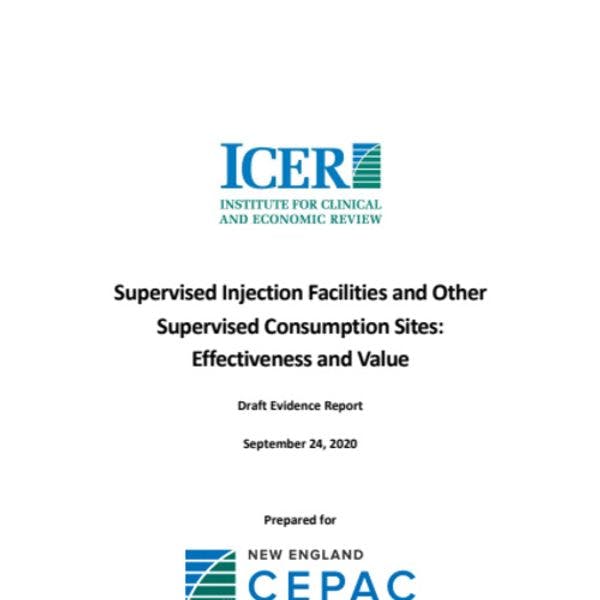Institute for Clinical and Economic Review
Supervised injection facilities and other supervised consumption sites: Effectiveness and value
By Armbrecht E. et al. - Institute for Clinical and Economic Review
The opioid overdose epidemic is devastating families and communities across the United States. Epidemiological studies from the US Centers for Disease Control and Prevention (CDC) recently reported a decline in overall life expectancy of Americans, which was attributed largely to drug-related overdose deaths. Today in the US, overdoses are classified as the leading cause of injury-related death. Between 2017 and 2018, across the nation, drug overdoses decreased 4.1% to 67,367 deaths, of which 69.5% involved an opioid. However, opioid-involved death rates during this period increased among persons aged 65 years or older, Hispanics, non-Hispanic Blacks, and for people living in the Northeast and West regions. In the Northeast region, synthetic opioids other than methadone drove the annual increase, with a 17.9%.
The CDC describes the observed increase in opioid overdose deaths as occurring in three distinct waves. The first wave, which began in the 1990s, involved prescription opioids. Beginning in 2010, the second wave was marked by heroin-involved deaths. The current wave involves synthetic opioids other than methadone (e.g., illicitly manufactured fentanyl and other fentanyl analogues) pushing mortality even higher. Within one year, from 2016 to 2017, synthetic opioid-involved overdose deaths increased by 45.2%. Another source of drug overdose deaths may be emerging; the age-adjusted death rate involving cocaine has more than tripled from 2012 to 2018 and psychostimulants (e.g., methamphetamine, amphetamine, and methylphenidate) has increased nearly 5-fold over the same period.
The public health approach to addressing the overdose epidemic is multi-faceted, involving a combination of policy, education, and community interventions. A framework developed by the Association of State and Territorial Health Organizations (ASTHO) describes a cross-sectoral response with four key strategy areas: (1) training and education; (2) monitoring and surveillance; (3) primary and overdose prevention; and (4) treatment, and harm reduction. For example, training and education of physicians and pharmacists can improve adherence to clinical practice guidelines for pain management and reduce the number of patients at risk for addiction and dependence. Expanding distribution channels of naloxone, an antidote for opioid overdose, can reduce rates of fatal overdose. For people who seek treatment or want to reduce frequency of opioid use, a variety of medication-assisted treatments (MATs) are effective, a topic addressed by ICER assessments in 2014 and 2018. The ASTHO framework recommends funding and implementing supervised injection facilities — also known as safer injection facilities, supervised consumption sites, or overdose prevention centers—as a harm reduction strategy, noting the program is evidence-based for reducing fatal opioid overdose and enhancing access to primary health care.
